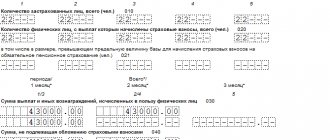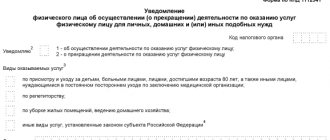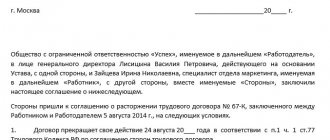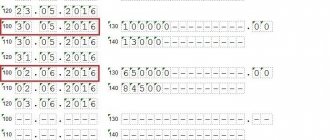Calculation of insurance premiums: fill out without errors
When sending a calculation for insurance premiums, you need to remember that the Federal Tax Service will compare its indicators with the calculation of 6-NDFL (letter of the Federal Tax Service dated March 13, 2017 No. BS-4-11 / [email protected] ).
1. If a company has submitted 6-NDFL, it is obliged to submit a calculation of insurance premiums.
2. Line 030 of subsection 1.1 of the calculation of contributions should not be greater than the difference between lines 020 and 025 of the 6-NDFL calculation. Equality is allowed.
Thanks to the new features of the program, settlements with founders and the preparation of tax reporting have been significantly simplified.
In previous versions of the program, settlements with founders were organized using analytics for counterparties (sub-account Counterparties).
Dividends - what is it?
Dividends are the profits of privately owned enterprises that remain after mandatory deductions: taxes, contributions, loan payments, wages, bonuses. It consists of the income received by the company for a specific period of time. By decision of the meeting of founders, profits are distributed among the persons who invested their money in its development.
People who invest money in a company are called investors. In a Limited Liability Company, these are the founders, participants, and shareholders. In a joint stock company, there are shareholders. Cash profits (dividends) are distributed among partners, stockholders, bondholders according to the share contributed by each of them to the enterprise. — Dividends are not subject to insurance premiums, since the profit distributed among investors reflects the property, and not the labor, form of the relationship.
What is the calculation of insurance premiums in 2020
In October 2020, by order of the Federal Tax Service of Russia (No. ММВ-7-11/551), a new report was approved, which essentially replaced the previously submitted reports in the field of insurance. Since that time, the administration of insurance premiums, with the exception of contributions for injuries, which continue to be transferred to the Social Insurance Fund, is carried out by tax control authorities.
As for all other aspects of the calculation and payment of insurance premiums, starting from 2020, they are concentrated in the hands of the Federal Tax Service.
The calculation of insurance contributions to the Federal Tax Service 2020 is a document that combines information on compulsory, pension and social insurance.
The structure of this document can be presented in the form of three sections, each of which reflects certain information.
Thus, Section 1 is used to disclose information about the calculated amount of insurance premiums for various reasons. Many applications allow you to structure the presented data.
Section 2 can only be used by companies or entrepreneurs whose main activities are related to agriculture, that is, it is used only by agricultural producers. Accordingly, this section does not fall into the category of mandatory tax report elements.
As for the calculation of insurance premiums for 2020, section 3, it is used as a source of information about personalized accounting in relation to each individual employee of the organization.
The question often arises about which section should contain information about an employee who is on sick leave or on parental leave. In the calculation of insurance premiums 2018, Appendix 3 of Section 1 is intended specifically for this purpose.
Questions about 4-FSS
Why may child care benefits for children under 3 years of age not be included in the 4-FSS and RSV reports?
Most likely, the error occurs due to the fact that the type of income for insurance premiums is incorrectly selected in the accrual settings Child care benefit for children under three years of age .
Probably, the value Income that is not subject to insurance premiums - such accruals are not reflected at all in the 4-FSS and DAM reports.
To correct the situation, you should indicate another type of income - Income that is entirely exempt from insurance contributions, except for benefits from the Social Insurance Fund and military allowances :
After this, you will need to re-post the documents Calculation of salaries and contributions in which the benefits were calculated. As a result, the data in the registers will be updated, and it will be possible to generate 4-FSS and RSV with new correct data.
On what date is the data in Table 5 of the 4-FSS report filled in?
Table 5 4-FSS report is filled out manually throughout the year with the same data on the first day of the year.
How to enter or adjust the debt at the beginning of the reporting period in 4-FSS in ZUP 3?
In this case, you can enter an “artificial” document on December 31 of the previous year, Payment of insurance contributions to funds (Taxes and contributions - Payment of insurance contributions to funds), where you indicate the required amount with a plus or minus:
Is it necessary to indicate in the program information that an employee is disabled?
Yes, we recommend filling out this information, as this will allow you to save a little on contributions for injuries.
Information that the employee is disabled should be entered into ZUP 3 in the employee’s card using the Insurance in the Disability Information :
Further, “injury” contributions for such an employee are calculated as 60% of the organization’s basic tariff.
After the certificate’s validity period expires, “injury” contributions are calculated at the usual rate, so in the Disability Information it is important to fill in the Validity period :
Information on disabled employees is reflected in the report Analysis of contributions to funds (Taxes and contributions - Reports on taxes and contributions - Analysis of contributions to funds) in the special table Accruals for disabled people :
The amount of income for disabled people in 4-FSS falls into special line 4 of Table 1 :
What should I indicate in 4-FSS in the average headcount field if all employees are part-time workers?
In this case, when automatically filling out 4-FSS, the Average number of employees field will not be filled in, because Part-time workers are not taken into account in the average headcount. When unloading, the program will not show any errors. However, upon admission, the FSS may ask you to fill out this field.
How to fill out Table 5 of the 4-FSS report if a special assessment (SOUT) has not been carried out?
Table 5 in form 4-FSS is mandatory for submission, therefore it must be filled out, indicating 0 in the appropriate cells.
Where to reflect the financing of preventive measures in the 4-FSS report?
Data on the financing of preventive measures are reflected in the 4-FSS manually in line 9 of Table 3 and in line 15 of Table 2 .
Where can I get the data to fill out Table 5 of the 4-FSS report?
All data in Table 5 4-FSS report must be entered based on information from the results of a special assessment of working conditions conducted by an authorized organization.
From the report for which period should the results of a special assessment of working conditions be shown in Table 5 of the 4-FSS report?
The data in Table 5 4-FSS report is completed on the first day of the year. Starting from 2020, employers will be able to apply the results of the SOUT from the moment information about them appears in the accounting information system. If, on the first day of the year, the results of the special assessment issued in October 2019 are published in the accounting information system, then in Table 5 the data on SOUT should be reflected starting with the report for the 1st quarter of 2020. The information indicated in Table 5 at the beginning of the year throughout the year are duplicated in 4-FSS .
How to calculate dividends?
Let us remind you that the first three days of illness are paid at the expense of the employer, the subsequent ones - at the expense of the Social Insurance Fund. Both types of payments are not subject to insurance premiums.
Information about sick leave is recorded in Appendix No. 2 to Section 1 of the calculation.
On line 020 of Appendix No. 2, you must indicate all payments to individuals, including hospital benefits.
On line 030 you need to show the amount of non-contributory payments. If we are talking about hospital benefits, they must be indicated in the full amount (parts paid both at the expense of the company and at the expense of the fund).
Financial assistance up to 4,000 rubles is not subject to insurance contributions (Article 422 of the Tax Code of the Russian Federation).
However, even such payments are reflected in the calculation of insurance premiums.
Financial assistance must be reflected:
- in Appendix No. 1 to Section 1 - lines 030 and 040 of subsections 1.1 and 1.2;
- in Appendix No. 2 to Section 1 - lines 020 and 030;
- in section 3 - column 210 of subsection 3.2.1.
The general procedure is determined by Art. 28 of the Federal Law of 02/08/1998 No. 14-FZ “On Limited Liability Companies”.
As before, the actual payment of dividends in 2020 is carried out with tax withholding. They are applied regardless of the year for which the accrual occurs, to payments made in 2018:
- Personal income tax for individuals - 13% (clause 1 of Article 224 of the Tax Code of the Russian Federation) for citizens of the Russian Federation and 15% (clause 3 of Article 224 of the Tax Code of the Russian Federation) for foreigners;
- income tax for legal entities - 13% (subclause 2, clause 3, article 284 of the Tax Code of the Russian Federation) for Russian companies and 15% (subclause 3, clause 3, article 284 of the Tax Code of the Russian Federation) for foreign legal entities.
For situations where dividends are issued to a legal entity that has owned more than a 50% stake in the capital company for at least a year, a 0% rate can be applied (subclause 1, clause 3, article 284 of the Tax Code of the Russian Federation).
When paying dividends to Russian organizations and individuals - residents of the Russian Federation, the amount of tax to be withheld from income is calculated according to the formula given in clause 5 of Art. 275 Tax Code of the Russian Federation.
K – the ratio of the amount of dividends subject to distribution in favor of the taxpayer - recipient of the dividends to the total amount of dividends subject to distribution by the Russian organization;
S n – tax rate (in percent);
D 1 – the total amount of dividends to be distributed by the Russian organization in favor of all recipients;
Dividends paid to Russian organizations are taxed at the rates established in paragraphs. 1 and 2 paragraphs 3 art. 284 Tax Code of the Russian Federation:
- for the general case, a rate of 13% applies;
- a preferential rate of 0% applies if, on the day of the decision to pay dividends, the Russian organization (founder) for at least 365 calendar days continuously owned by right of ownership at least 50% of the contribution in the authorized capital of the organization paying dividends, giving the right to receive dividends in an amount corresponding to at least 50% of the total amount of dividends paid.
When Russian organizations pay dividends to individuals who are residents of the Russian Federation, the personal income tax rate on dividends in 2018 is applied in the amount of 13%, established by paragraph 1 of Article 224 of the Tax Code of the Russian Federation.
For individuals who are not tax residents of the Russian Federation, a rate of 15% is generally applied (clause 3 of Article 224 of the Tax Code of the Russian Federation).
International treaties on the avoidance of double taxation between the Russian Federation and a foreign state may provide for preferential rates when paying dividends.
This confirmation must be submitted before the date of payment of income and certified by the competent authority of the relevant foreign country. For example, in paragraph
What should confirmation look like that the organization has the actual right to income? The Tax Code of the Russian Federation does not answer this question. The Ministry of Finance and the Federal Tax Service explain that the list of such documents is open.
At the same time, the legislator does not limit tax agents to any forms or list, giving preference to the content of the information received by the tax agent (letter of the Ministry of Finance of Russia dated June 29, 2017 N 03-08-05.41203).
How to reflect sick leave payments
Many questions arise about whether it is necessary to reflect paid dividends in the calculation of insurance premiums in 2020 (the terms were discussed above). Dividends are not included in the ERSV as non-taxable income. Accordingly, if only dividends were paid to the staff, then dashes must be placed in the report columns. In the same case, if dividends were among other payments for the period, income must be reflected in the usual manner.
The procedure for filling out calculations for insurance premiums was approved by Order of the Federal Tax Service dated October 10, 2016 No. ММВ-7-11/ [email protected]
Let us remind you that the first three days of illness are paid at the expense of the employer, the subsequent ones - at the expense of the Social Insurance Fund. Both types of payments are not subject to insurance premiums.
Information about sick leave is recorded in Appendix No. 2 to Section 1 of the calculation.
On line 020 of Appendix No. 2, you must indicate all payments to individuals, including hospital benefits.
On line 030 you need to show the amount of non-contributory payments. If we are talking about hospital benefits, they must be indicated in the full amount (parts paid both at the expense of the company and at the expense of the fund).
But on line 070 you need to reflect only that part of the benefits that was paid at the expense of the Social Insurance Fund.
If there is a pilot project in the region, according to which sick leave is paid directly to the employee, “0” must be entered in line 070 of Appendix No. 2.
Financial assistance up to 4,000 rubles is not subject to insurance contributions (Article 422 of the Tax Code of the Russian Federation).
https://youtu.be/_zqlvCwF8gk
However, even such payments are reflected in the calculation of insurance premiums.
Financial assistance must be reflected:
- in Appendix No. 1 to Section 1 - lines 030 and 040 of subsections 1.1 and 1.2;
- in Appendix No. 2 to Section 1 - lines 020 and 030;
- in section 3 - column 210 of subsection 3.2.1.
Dividends are paid to the founders of the company. The founders can be:
- employees of the organization;
- persons who do not work for the company.
Regardless of the status of the person, dividends do not need to be reflected in the calculation of insurance premiums.
Dividends are not subject to insurance premiums, since they are not subject to taxation in accordance with Art. 420 Tax Code of the Russian Federation.
Insurance premiums in case of temporary disability and in connection with maternity, as well as from accidents that occur during working hours, are levied on the following individuals:
- stipulated by the GPC agreements on the performance of work (provision of services);
- calculated within the framework of labor relations;
- appointed under author order agreements, as well as under licensing publishing agreements, agreements for the right to use works of literature, science, art, etc.
Such provisions are provided for in paragraph 1 of Art. 7 of the Law “On Insurance Contributions...” dated July 24, 2009 No. 212-FZ, as well as clause 1 of Art. 20.1 of the law “On compulsory social insurance against accidents at work...” dated July 24, 1998 No. 125-FZ.
Dividends are the income remaining after calculating income tax, which is divided between the founders of the company or shareholders based on the results of the enterprise’s work. In this case, dividends can be paid every 3, 6, 9 or 12 months.
The right of the founder (shareholder) of the company to a share in the charter capital is the basis for assigning dividends. Their payment is carried out on the basis of the decision of the shareholders (founders).
For a sample of such a decision, see the publication “Decision on the payment of dividends to an LLC - sample and order.”
For the accounting entries for dividends, see the article “Accounting Entries for the Payment of Dividends.”
Thus, dividends paid to individuals are not subject to Social Security contributions, since when dividends are assigned, legal relations arise between the company and its shareholder (participant) in terms of the founder’s property rights to a share in the authorized capital. There are no labor or civil law relationships in this situation.
Based on the above, a logical question arises for accountants: “Are dividends reflected in 4-FSS as part of non-contributory remuneration amounts?”
The amounts of staff remuneration that are not subject to contributions are displayed on page 2 of the table. 3 statements 4-FSS.
Sec. Statement II 4-FSS also contains page 2 of table. 6 to display remunerations that are not subject to contributions from the National Tax Service at work. At the same time, in gr. 3 indicates the total amount of payments for the reporting period, and in gr. 4, 5, 6 - breakdown of the last 3 months.
The list of such payments is strictly limited by Art. 9 of Law No. 212-FZ and Art. 20.2 of Law No. 125-FZ.
Therefore, there is no need to display dividends in 4-FSS, since they are not listed in these lists.
With details of filling out page 2 of table. 3 can be found in the material “Completing Table 3 of the 4-FSS report - rules and sample.”
If dividends were erroneously included in 4-FSS and led to an underestimation of the amount of contributions, then an adjustment report must be submitted.
IMPORTANT! The adjustment is submitted in the form that was in effect in the reporting period for which the error was discovered.
In this case, before sending the updated calculation, you need to pay the arrears and penalties if the deadline for paying contributions for the reporting period has already passed. Otherwise, the FSS will impose penalties in the amount of 20% of the amount of contributions.
The company expects the same fine if the error is discovered by Social Insurance employees during an on-site inspection. In this case, there is no need to submit a clarification. The inspectors will independently charge additional fees and make a decision on the inspection, on the basis of which the amount of arrears should be reflected in page 3 of the table. 1, if the error was made in the current year, or in page 4 of the table. 1, if in previous reporting periods.
Example
The accountant of Lik LLC mistakenly included Table 2 on page 2. 3 statements 4-FSS for the 1st quarter. 2020 dividends paid to the founder for 2020. Based on the results of the on-site inspection, FSS inspectors identified this error, added additional contributions and issued a fine. Based on the decision received, the accountant reflected the amount of arrears in 4-FSS for the current period.
If the error in the 4-FSS statement did not in any way affect the amount of contributions, for example, the amount of dividends was included in pages 1 and 2 of the table. 3, or led to an overpayment, then the company has the right to submit an adjustment, but is not obliged (clause 2 of Article 17 of Law No. 212-FZ of July 24, 2009).
Where to submit calculations for insurance premiums 2020
In accordance with the instructions for filling out the calculation of insurance premiums, approved by the order of the Federal Tax Service discussed above, the specified document must be submitted to the authorized bodies by companies and businessmen that have employees operating on the basis of signed labor contracts. Thus, the need to generate a new tax report is not tied to the legal status of the employer.
Due to the fact that the calculation of insurance premiums is compiled on an accrual basis from the beginning of the calendar year. Accordingly, even if the employer said goodbye to all of its employees during the reporting period, the company or entrepreneur has to draw up a reporting document until the end of the year.
The body responsible for receiving the tax document on insurance contributions is the Federal Tax Service. Organizations must submit the calculation to the territorial Federal Tax Service at the place of their registration. As for individual entrepreneurs, they should report to the tax authorities at their place of residence.
How to report to separate departments
A separate division independently calculates insurance premiums and reports to the Federal Tax Service only in one case - when the parent organization has officially vested it with the authority to charge payments to individuals (clause 11 of Article 431 of the Tax Code of the Russian Federation).
If you have the appropriate authority, in the calculation of insurance premiums, which is submitted for a separate division, you need to indicate only charges and contributions for the division.
In turn, the company that has given the corresponding powers to a separate division is obliged to report this fact to the Federal Tax Service at its location (clause
7 p. 3.
4 tbsp. 23 of the Tax Code of the Russian Federation). The parent organization has a month to do this from the date the powers of the separate division are vested.
If a separate division has not received authority regarding insurance premiums, the parent company at its location is obliged to submit calculations for insurance premiums.
This calculation includes data for both the parent organization and a separate division. In the calculation, OKTMO of the parent organization should be indicated.
Many questions arise among accounting workers if the company has separate divisions. If there are divisions, the payment of insurance premiums and the provision of tax reporting must be carried out at the place of direct payment of income in favor of individuals, that is, at the location of the separate division.
Enterprise income not subject to taxation
First of all, these are those amounts of money that do not themselves form an object of taxation.
- Donation amounts. An employer can give his employee a certain amount of money for good work.
- Loan payments.
- Payments for rent or purchase and sale of property.
- Enterprise dividends.
That is, we have come to the main question: are company dividends subject to insurance payments? Dividends are not subject to taxation on the basis of a letter from the fund inspection (FSS No. 15-03-11/08-13985).
How to correctly reflect dividends in the 6-personal income tax form?
Attention
The calculated tax on dividends is also reflected twice:
- on line 040 “Amount of calculated tax”, personal income tax on dividends will be reflected as part of the total amount of calculated tax on income reflected on line 020;
- line 045 “Including the amount of calculated tax on income in the form of dividends” indicates exclusively the tax on dividends that were separately reflected in line 025 of the Calculation.
Personal income tax on dividends is withheld at a rate of 13% (for residents) or 15% (non-residents) (Article 224 of the Tax Code of the Russian Federation).
Therefore, on lines 020, 025, 040, 045, dividends and the tax on them will be reflected on those sheets of Section 1, where the corresponding personal income tax rate is indicated on line 010 “Tax rate, %”.
Dates for dividends in form 6-NDFL The date of actual receipt of dividends (line 100 of the Calculation) is the day of their payment (transfer to a bank account or withdrawal from the cash register) (clause.
1 clause 1 art.
Dividends in 6-NDFL: example of filling out 2020
Personal income tax – those that are subject to personal income tax. Based on these discrepancies, the calculation of insurance premiums will be accepted, but the Federal Tax Service may require clarification. What not to avoid. Explanations must be provided within 5 working days (clause 3 of Article 88 of the Tax Code of the Russian Federation) in electronic form, or within 10 working days if the report was submitted on paper.
An example of an explanation in the Federal Tax Service When clarification is needed, the Federal Tax Service of Russia reports that if in the DAM information on the total amount of insurance contributions for compulsory pension insurance (Section 1) does not correspond to information on calculated contributions for each insured person (Section 3) and if the inspection found unreliable personal data, such calculation will be considered not submitted, and appropriate notification will be sent.
Tax agent reporting
The payment of dividends to the LLC is accompanied by the submission of reporting:
- 2-NDFL certificates submitted to the Federal Tax Service before April 1 of the year following the reporting year (see letter of the Ministry of Finance of Russia dated October 19, 2015 No. 03-03-06/1/59890);
- 6-NDFL report submitted to the Federal Tax Service on a quarterly basis no later than the last day of the month following the reporting quarter and (for the year) before April 1 of the year following the reporting one;
For more information about entering data on dividends in Form 6-NDFL, read the material “How to correctly reflect dividends in Form 6-NDFL?”.
- for profit - in the form of a declaration, which, in addition to the title page, includes subsection 1.3 of section 1 and sheet 03, submitted to the Federal Tax Service within the deadlines established for such reporting: interim - before the 28th day of the month following the reporting period, final (for the year) - until March 28 of the following year.
For more information on filling out sheet 03, see the article “What is the procedure for filling out an income tax return (example).”
The reporting procedure depends on the type of organizational form of the company that issues dividends: LLC or JSC.
In each situation, it is necessary to prepare and submit 2-NDFL certificates and 6-NDFL reports for each dividend recipient. They indicate the amounts received by each of the founders.
The 2-NDFL report is submitted before April 1 of the year following the reporting year. The 6-NDFL report must be submitted no later than the last one for the month following the reporting quarter.
In addition, the law requires filing an income tax return. However, only joint stock companies need to do this. The Ministry of Finance clarified in its letter that LLCs do not prepare this report.
Attention! The declaration on NP is drawn up in this way: the title page is filled out, section A is filled out on sheet 03, after which Appendix 2 is filled out for each recipient of dividends. The report is sent before March 28 of the year following the year of transfer of dividends.
If the recipient of dividends is a foreign company, then it is necessary to submit a tax calculation (information) on the amounts of income paid and taxes withheld.
Payment. When paying tax on dividends, indicate KBK 182 1 0100 110 in the payment order. It is entered in field 104. The code must consist of 20 characters.
Sample payment order when transferring personal income tax on dividends in 2020
2-NDFL. Indicate the amount of dividends with personal income tax in section 3 of the certificate.
Use income code – 1010 (Appendix 1 to the order of the Federal Tax Service of Russia dated September 10, 2020 No. ММВ-7-11.387). If your organization received dividends from other companies and you took them into account when calculating tax, indicate the amount of the deduction in section 3 of the certificate.
6-NDFL. Include the amount of income paid, taking into account personal income tax, in the indicator on line 020, indicate the amount of dividends separately in line 025. Include accrued personal income tax in line 040, and separately reflect the tax on dividends in line 045. In line 070, show the withheld tax on payments.
Why are insurance premiums not calculated from dividends?
These contributions are deducted from remuneration under employment and civil contracts in accordance with Article 420 of the Tax Code of the Russian Federation. In other words, wages, bonuses, and payments for a certain amount of work are taxed.
Dividend payments to shareholders are not a means of stimulating labor; they are not subject to contributions, regardless of the employee’s position. However, according to Article 207 of the Tax Code of the Russian Federation, personal income tax must be transferred from them. The obligation to withhold and transfer personal income tax from recipients lies with the tax agent company.
Fill out 6-NDFL
In the part of the 6-NDFL report reflecting income, profit received from shares, bonds and transfers to the authorized capital is taken into account.
We fill out the report according to the template:
Line 020: add dividends to taxable income.
Line 025: we write down the amount of payments on shares.
Line 030: tax deductions.
Line 040: (page 020 - page 030)*13/100.
Line 045: page 025*13/100.
Calculation of insurance premiums 2020: due date
The report “Calculation of insurance premiums” 2020 belongs to the category of quarterly reports. This means that at the end of each quarter, policyholders must generate, review and submit a single calculation of insurance premiums for 2020.
Calculation of insurance premiums 2020 - deadlines for submission to the inspection are established within the 30th day of the month following the reporting quarter.
Accordingly, the calculation of insurance premiums for the 1st quarter of 2018 must be submitted to the tax authorities by April 30, 2020. The report for the half-year is submitted to the Federal Tax Service by July 30, 2020, for nine months - no later than October 30, and the report for 2020 must be submitted by January 30, 2020.
Dividends in RSV
Calculation of insurance contributions - a consolidated, individual report on mandatory monetary contributions of the company, employee to the Social Insurance Fund, Pension Fund, Compulsory Medical Insurance.
Are dividends reflected in the calculation of insurance premiums in 2019? The articles of the Tax Code and the letter from the Social Insurance Fund show that the DAM must include information about deductions from those types of earnings that are subject to insurance contributions. Dividends are not reflected in the DAM, because their payments are not regulated by labor relations. Information about the amounts paid to shareholders is not reflected in the calculation of insurance premiums.
Adjustment of calculation of insurance premiums 2020
Tax workers allow the opportunity to correct already submitted tax reports by providing an updated calculation of insurance premiums for 2020. The newly generated document will need to reflect the serial number of the adjustment made, as well as record the correct information on the lines of calculation for insurance premiums.
Accordingly, the corrective calculation for insurance premiums for 2018 should be provided in a manner similar to the delivery of the original version of the document.
What affects the size
The amount of these deductions can vary quite significantly depending on a number of factors.
The main ones are the following:
- the need to stabilize the economic situation of the enterprise;
- attracting investments;
- changes in the economic climate in the country, directly in the field of activity of the enterprise;
- demonstration of development prospects;
- interests of the enterprise.
The amount of transfers to the shareholder decreases or remains at the same level, often due to the need to stabilize the economic situation in the enterprise itself.
To develop a business, regardless of the field of activity, certain cash injections will be required. in the absence of these, it will simply be impossible to carry out development and increase profits.
Often funds for this are found by reducing payments on shares and other securities.
Investments can also be attracted in other ways. For example, by demonstrating development prospects. One of the criteria is the profitability of the enterprise, the stability of deductions on securities. This factor can significantly influence the policies of shareholders when distributing profits among themselves.
Restrictions on payment of dividends to founders
We must never forget that every operation within the framework of the activities of any organization is subject to clear regulation by the relevant authorities. Therefore, before making a decision on the distribution of profits, it is necessary to make sure whether the organization has the right to take this action. There are a number of restrictions under which dividends cannot be paid:
- the authorized capital has not been fully paid up; depending on the situation, the share may be redistributed among the remaining founders or, in the worst case, the organization may be liquidated due to a claim from the tax authorities;
- the organization did not repay the debt to one of the share investors who expressed a desire to leave the share ownership;
- the organization, for some reason, is on the verge of bankruptcy or there are obvious reasons that could lead to it;
- the amount of net assets after the closing of the reporting period according to accounting data turned out to be less than the amount of the authorized capital, this condition is mandatory for all organizations and is enshrined in a regulation approved by the Ministry of Finance;
- at the end of the reporting period there is an uncovered loss.
What are dividends and are they subject to insurance premiums?
The question deserves special attention: are dividends subject to insurance premiums? It is worth carefully familiarizing yourself with the main provisions of the Tax Code of the Russian Federation, as well as various other points.
The fundamental legal document is Federal Law No. 212-FZ of July 24, 2009 “On Insurance Premiums”.
In accordance with it, in all of the above, the state extra-budgetary funds should be carried out only upon receipt of wages. That is, it means receiving funds specifically for performing certain work, within the framework of an employment contract.
At the same time, the type of profit under consideration is not wages; an agreement of a different nature is drawn up.
The main documents within which dividends are paid are the following:
- Charter of the joint stock company;
- an agreement entered into when purchasing a certain type of security.
Fundamental articles:
- Art. No. 214 of the Tax Code of the Russian Federation;
- Art. No. 275 of the Tax Code of the Russian Federation;
- Article No. 284 of the Tax Code of the Russian Federation.
Insurance premiums in case of temporary disability and in connection with maternity, as well as from accidents that occur during working hours, are levied on the following individuals:
- stipulated by the GPC agreements on the performance of work (provision of services);
- calculated within the framework of labor relations;
- appointed under author order agreements, as well as under licensing publishing agreements, agreements for the right to use works of literature, science, art, etc.
Such provisions are provided for in paragraph 1 of Art. 7 of the Law “On Insurance Contributions...” dated July 24, 2009 No. 212-FZ, as well as clause 1 of Art. 20.1 of the law “On compulsory social insurance against accidents at work...” dated July 24, 1998 No. 125-FZ.
Dividends are the income remaining after calculating income tax, which is divided between the founders of the company or shareholders based on the results of the enterprise’s work. In this case, dividends can be paid every 3, 6, 9 or 12 months.
The right of the founder (shareholder) of the company to a share in the charter capital is the basis for assigning dividends. Their payment is carried out on the basis of the decision of the shareholders (founders).
For the accounting entries for dividends, see the article “Accounting Entries for the Payment of Dividends.”
Are insurance premiums charged?
The Tax Code provides comprehensive information on the types of income from which mandatory contributions are made to extra-budgetary funds. To answer the question “Are dividends subject to insurance contributions or not?”, you need to study the list of types of earnings from which interest is taken in the Social Insurance Fund, the Pension Fund of the Russian Federation, the Unified Social Tax is subject to:
- salaries;
- bonuses;
- payment under the contract;
- fees.
Contributions to the Social Insurance Fund, Pension Fund and other non-budgetary organizations are levied on all types of cash payments received under an employment agreement. From this list you can see what income is not eligible for insurance premiums. For the reason that they are issued not for labor, but for monetary capital invested in the enterprise. If an employee or manager turns out to be its investor, contributions to the Social Insurance Fund and the Pension Fund of the Russian Federation are made from his salary, bonuses and other payments required by the state. Insurance premiums are not collected from the founder's dividends.
Dividend payment procedure
If dividends were paid in violation of the procedure established by law, they may be reclassified. For example, if the sole founder (aka director) of a company paid dividends in the absence of net profit or in an amount greater than net profit in the current period, the dividends may be re-qualified.
In addition, you will have to pay additional insurance premiums. And the decision made on payments in this case will not be enough to recognize them as dividends.
Directions for using profit by an individual entrepreneur
The income of an individual entrepreneur is his net profit, which remains after deducting all expenses, paying all prescribed taxes and other obligatory payments. According to existing legislation, an entrepreneur has every right to freely dispose of his income, since he is the sole owner of all money earned from business activities. Also, there is no regulation of the areas of use of profit; accordingly, payment of income from equity participation to oneself in this situation cannot be.
Filling out the calculation
In addition to the question of whether to include dividends in the calculation of insurance premiums, it is necessary to fill out this document correctly so that there are no errors in it, since this can lead to fines and the need to redo the documentation.
There are certain requirements that must be observed when filling out:
- Amount indicators are recorded in rubles and kopecks.
- when drawing up a document manually, blue, black and violet ink are allowed;
- if there are no indicators at all, then in the column you need to put dashes instead of text (or zeros, if there are such indicators);
- you should also follow the rules for formatting this documentation in electronic form to avoid violations;
- dismissed employees are listed in a separate section indicating all the necessary information;
- It is necessary to number the pages when the document is completely completed.
You can also look at samples of filling out such documentation if you suddenly have doubts. This will help you make the calculation as needed. In addition, if you pay attention to them, you will see that dividends are not included in the calculation of insurance premiums.
Also see “What payments are not subject to insurance premiums in 2018.”
Let's consider what questions the policyholder may have when filling out the form:
- What tariff code should be reflected in the document? When calculating insurance premiums for 2020, the tariff code depends on which tax regime the policyholder applies: 01 – OSNO, 52 – USN, 53 – UTII.
- How to fill out the payment attribute column? In the calculation of insurance premiums for 2020, the payment attribute suggests two possible options: 1 – direct payments, 2 – offset payments. Direct payments mean that benefits will be paid to the employee directly from the extra-budgetary fund, bypassing the employer. However, in practice, direct payments relate to a pilot project of the Federal Tax Service and are not relevant for all regions. The offset system assumes that the payment of benefits is entrusted to companies, which will later be reimbursed by the fund for the expenses incurred.
Calculation of insurance premiums in 2020 - the premium calculator is presented in various Internet resources - is one of the most important tax reports in the system for calculating and paying insurance premiums.
Options for including dividends in the report and their consequences
By mistake, data on dividends may be included in the information shown in Table 1 of the report. Variants of this error include the inclusion of dividend amounts:
- In the total amount of income and in the amount of non-taxable payments. As a result, the taxable base will be calculated correctly.
- In the total amount of income without reflection in the amount of non-taxable payments. If, at the same time, contributions for dividends were not accrued, then the report will reveal a discrepancy between the data between tables 1 and 2. If there was an accrual, there will be no inconsistencies in the report, but the policyholder will pay to the Social Insurance Fund the amount of contributions that he could not have paid.
- The amount of non-taxable payments is not reflected in the total income. This will result in an underestimation of the assessment base shown in Table 1 and an inconsistency between Tables 1 and 2 if contributions were assessed correctly during the reporting period.
Errors in reporting, if they do not entail an understatement of the amount of accrued contributions, do not need to be corrected (clauses 1.1, 1, 2 of Article 24 of Law No. 125-FZ).
The discrepancy between the figures entered in tables 1 and 2 will not allow the FSS to accept it. Such an error will have to be corrected, even if the contributions were calculated correctly. This point may lead to failure to meet the reporting deadline.
Errors in 4-FSS are corrected by submitting an adjustment report.
Main nuances
The main ones include the following:
- when paying contributions until 2020 to resident individuals, the personal income tax rate will be only 9%;
- after 2020, the personal income tax for resident individuals will be 13%;
- It is possible to calculate the dividends themselves from net profit - which remains after the procedure for deducting all taxes in favor of the state budget.
Another important factor is the lack of possibility of applying tax deductions in relation to personal income tax. Many believe that since the tax is designated as personal income tax when calculating it for deduction, it will be possible to return it through deductions due to various types of benefits.
A complete list of such deductions is presented directly in Articles No. 218, 219, 220, 221 of the Tax Code of the Russian Federation.
In this case, the size of the tax base is necessarily formed separately for each type. This moment is established by clause.
2 Article No. 210 of the Tax Code of the Russian Federation.
Taxes payable on dividends
The following taxes must be paid on dividends:
| Resident/Non-Resident | Persons | Tax | Bid |
| Residents | Individuals | Personal income tax | 13% |
| Legal entities | Income tax | 13% | |
| Legal entities with a share of more than 50% | Income tax | 0% | |
| Non-residents | Individuals | Personal income tax | 15% |
| Legal entities | Income tax | 15% |
| ★ Best-selling book “Accounting from scratch” for dummies (understand how to do accounting in 72 hours) > 8,000 books purchased |
If a legal entity receives
The situation when a legal entity receives the corresponding funds on its balance sheet deserves special attention. In general cases, the income tax rate will be exactly 9%.
This point was previously regulated by clauses 2, 3 of Article No. 384 of the Tax Code of the Russian Federation.
But from 01/01/15 this parameter also increases to 13%. There are features of transfers to the budget.
Most of the rules apply to a legal entity that also apply to individuals. For example, it is the joint stock company that must make all transfers to the state budget and act as a tax agency.










